实验3:OpenFlow协议分析实践
作业链接:实验3:OpenFlow协议分析实践
一、实验目的
- 能够运用 wireshark 对 OpenFlow 协议数据交互过程进行抓包;
- 能够借助包解析工具,分析与解释 OpenFlow协议的数据包交互过程与机制。
二、实验环境
- 下载虚拟机软件Oracle VisualBox;
- 在虚拟机中安装Ubuntu 20.04 Desktop amd64,并完整安装Mininet;
三、实验要求
(一)基本要求
1.搭建下图所示拓扑,完成相关 IP 配置,并实现主机与主机之间的 IP 通信。用抓包软件获取控制器与交换机之间的通信数据包。
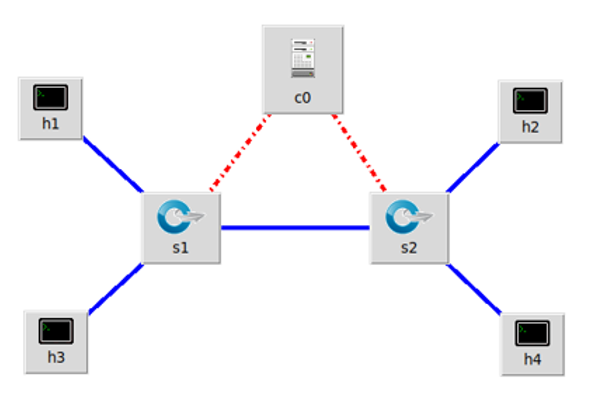
| 主机 | IP地址 |
|---|---|
| h1 | 192.168.0.101/24 |
| h2 | 192.168.0.102/24 |
| h3 | 192.168.0.103/24 |
| h4 | 192.168.0.104/24 |
- 构建拓扑
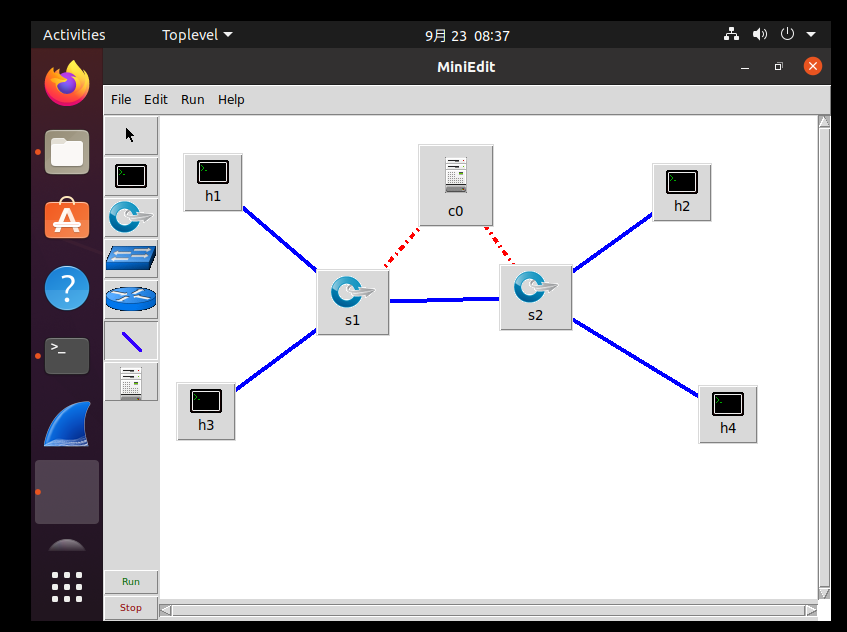
- 配置子网掩码和ip地址(只给出h1和h2的ip配置,其他是一样的)
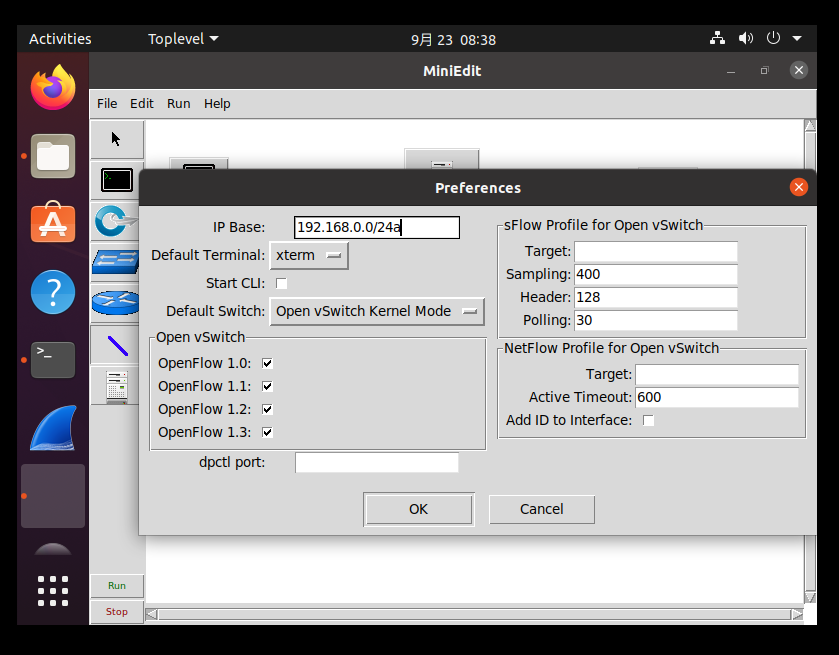
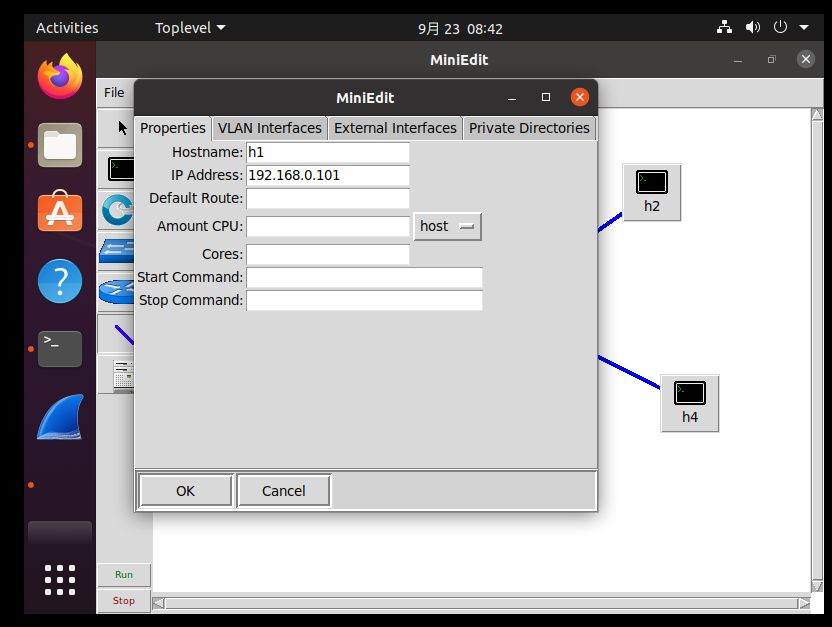
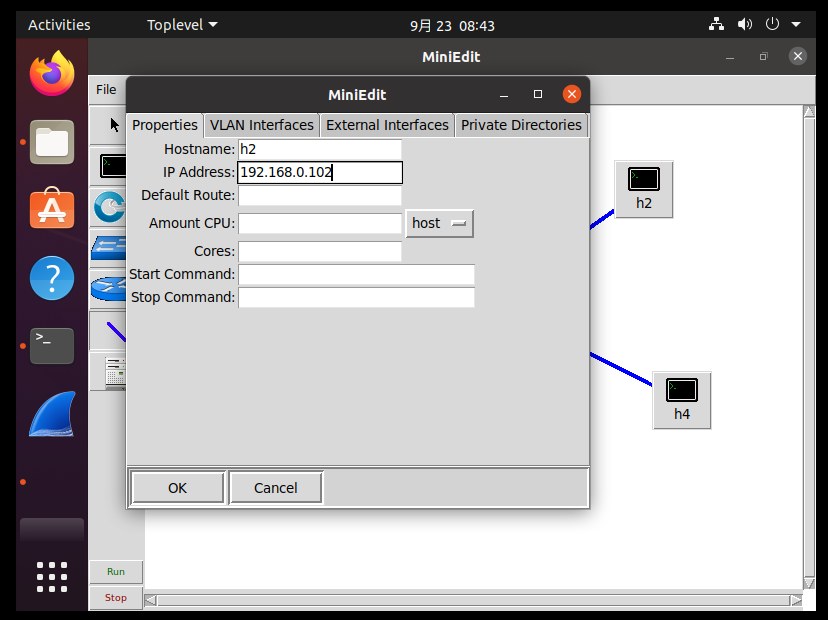
- 检查
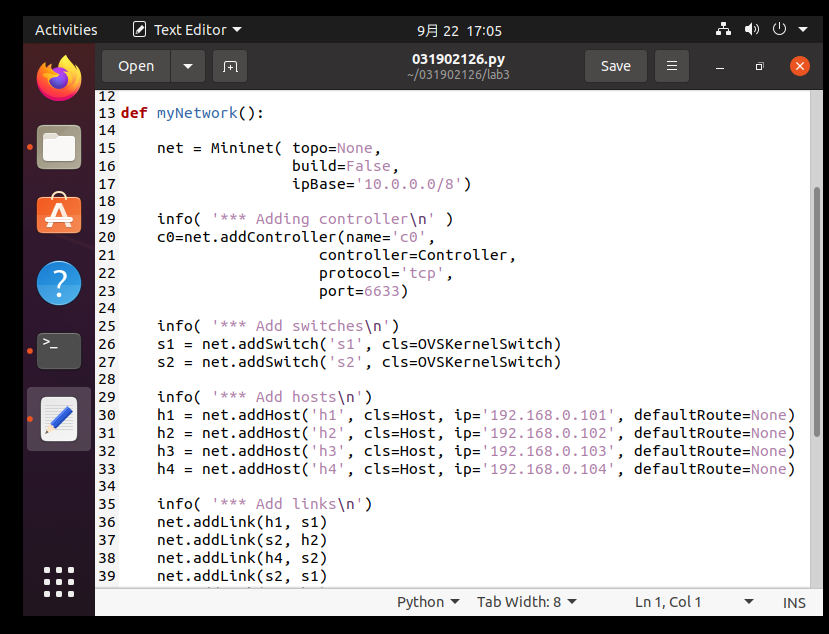
2.查看抓包结果,分析OpenFlow协议中交换机与控制器的消息交互过程,画出相关交互图或流程图。
- 在构建拓扑之前打开wireshark(选择any),然后运行文件并pingall。

- 查看抓的包
1.OFPT_HELLO
从6633端口到43820端口,openflow1.0协议

从43820端口到6633端口,openflow1.5协议

2.OFPT_FEATURES_REQUEST 从6633端口到43820端口
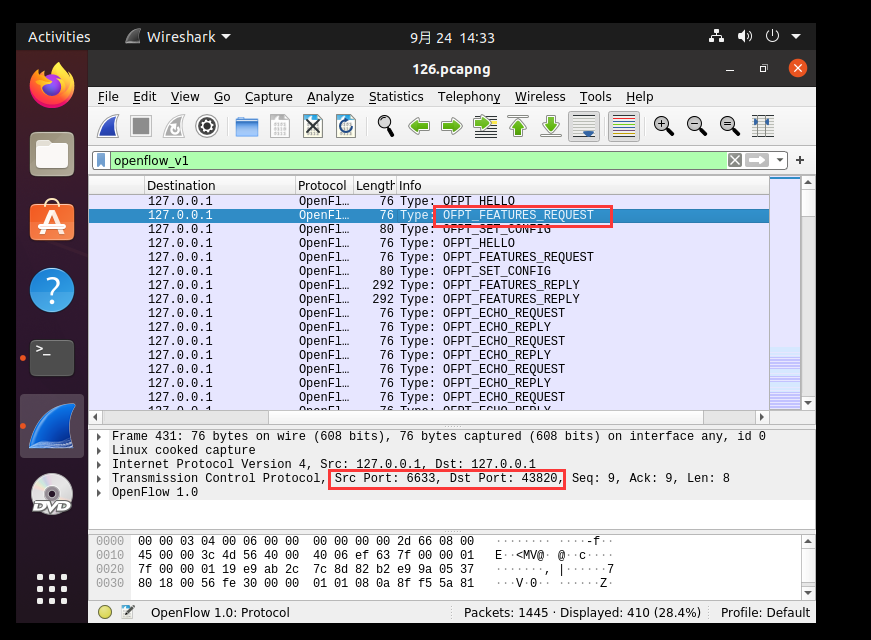
3.OFPT_SET_CONFIG 从6633端口到43820端口

4.OFPT_PORT_STATUS 从43820端口到6633端口
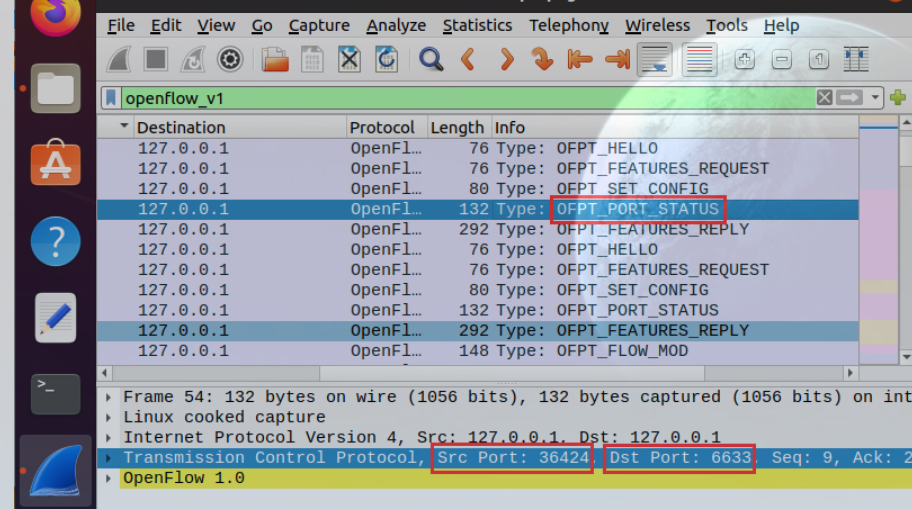
5.OFPT_FEATURES_REPLY 从43820端口到6633端口

6.OFPT_PACKET_IN 从43820端口到6633端口

7.OFPT_PACKET_OUT 从6633端口到43820端口
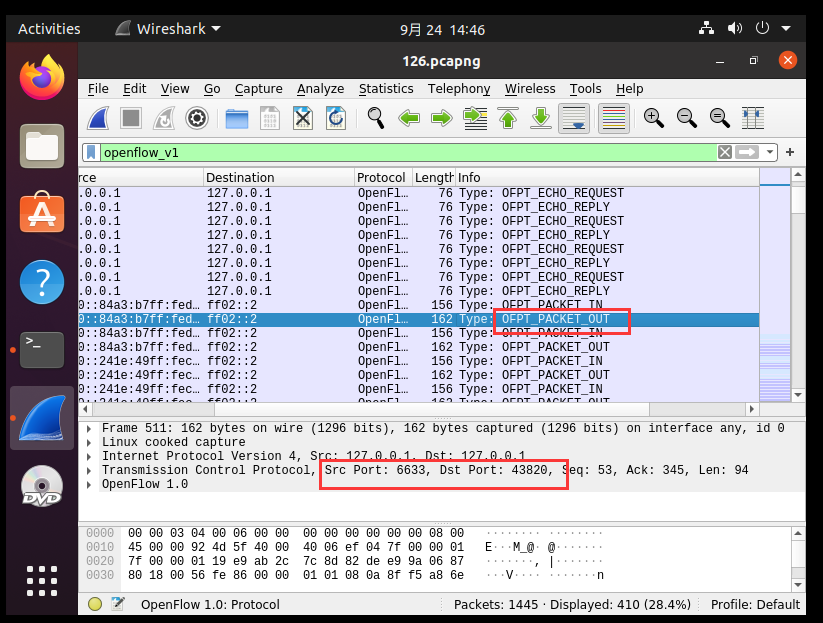
8.OFPT_FLOW_MOD 从6633端口到43820端口
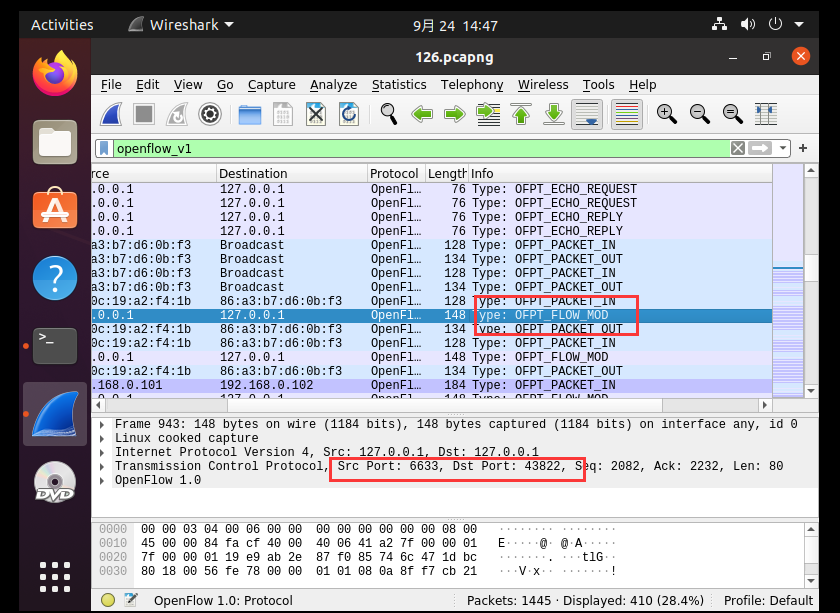
- 对应流程图如下:

3.回答问题:交换机与控制器建立通信时是使用TCP协议还是UDP协议?
Transmission Control Protocol即TCP协议
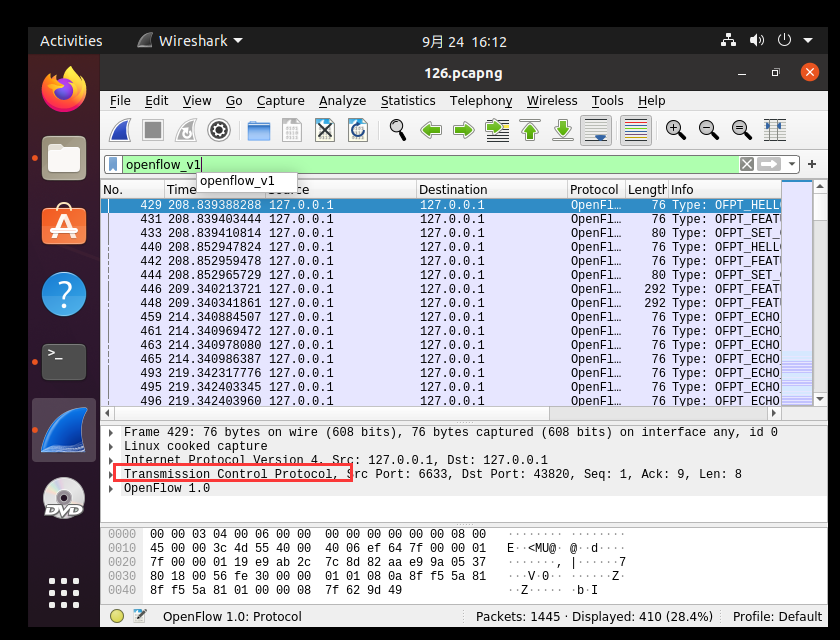
(二)进阶要求
将抓包结果对照OpenFlow源码,了解OpenFlow主要消息类型对应的数据结构定义。
1.HELLO
struct ofp_header {uint8_t version; /* OFP_VERSION. */uint8_t type; /* One of the OFPT_ constants. */uint16_t length; /* Length including this ofp_header. */uint32_t xid; /* Transaction id associated with this packet.Replies use the same id as was in the requestto facilitate pairing. */};struct ofp_hello {struct ofp_header header;};
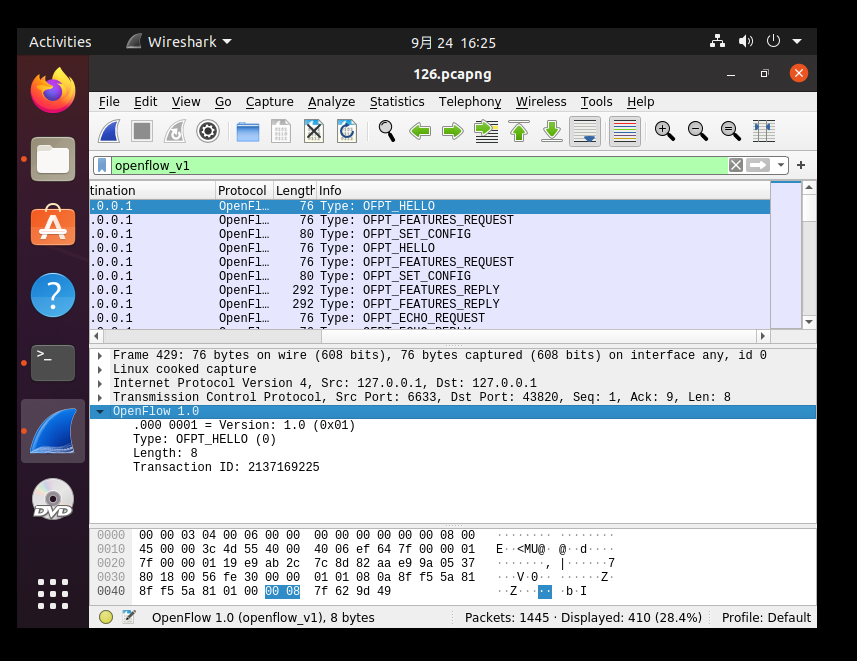
2.OFPT_FEATURES_REQUEST
源码与HELLO类似

3.OFPT_SET_CONFIG
/* Switch configuration. */struct ofp_switch_config {struct ofp_header header;uint16_t flags; /* OFPC_* flags. */uint16_t miss_send_len; /* Max bytes of new flow that datapath shouldsend to the controller. */};

4.OFPT_PORT_STATUS
/* A physical port has changed in the datapath */struct ofp_port_status {struct ofp_header header;uint8_t reason; /* One of OFPPR_*. */uint8_t pad[7]; /* Align to 64-bits. */struct ofp_phy_port desc;};

5.OFPT_FEATURES_REPLY
struct ofp_switch_features {struct ofp_header header;uint64_t datapath_id; /* Datapath unique ID. The lower 48-bits are fora MAC address, while the upper 16-bits areimplementer-defined. */uint32_t n_buffers; /* Max packets buffered at once. */uint8_t n_tables; /* Number of tables supported by datapath. */uint8_t pad[3]; /* Align to 64-bits. *//* Features. */uint32_t capabilities; /* Bitmap of support "ofp_capabilities". */uint32_t actions; /* Bitmap of supported "ofp_action_type"s. *//* Port info.*/struct ofp_phy_port ports[0]; /* Port definitions. The number of portsis inferred from the length field inthe header. */};/* Description of a physical port */struct ofp_phy_port {uint16_t port_no;uint8_t hw_addr[OFP_ETH_ALEN];char name[OFP_MAX_PORT_NAME_LEN]; /* Null-terminated */uint32_t config; /* Bitmap of OFPPC_* flags. */uint32_t state; /* Bitmap of OFPPS_* flags. *//* Bitmaps of OFPPF_* that describe features. All bits zeroed if* unsupported or unavailable. */uint32_t curr; /* Current features. */uint32_t advertised; /* Features being advertised by the port. */uint32_t supported; /* Features supported by the port. */uint32_t peer; /* Features advertised by peer. */};

6.OFPT_PACKET_IN
struct ofp_packet_in {struct ofp_header header;uint32_t buffer_id; /* ID assigned by datapath. */uint16_t total_len; /* Full length of frame. */uint16_t in_port; /* Port on which frame was received. */uint8_t reason; /* Reason packet is being sent (one of OFPR_*) */uint8_t pad;uint8_t data[0]; /* Ethernet frame, halfway through 32-bit word,so the IP header is 32-bit aligned. Theamount of data is inferred from the lengthfield in the header. Because of padding,offsetof(struct ofp_packet_in, data) ==sizeof(struct ofp_packet_in) - 2. */};
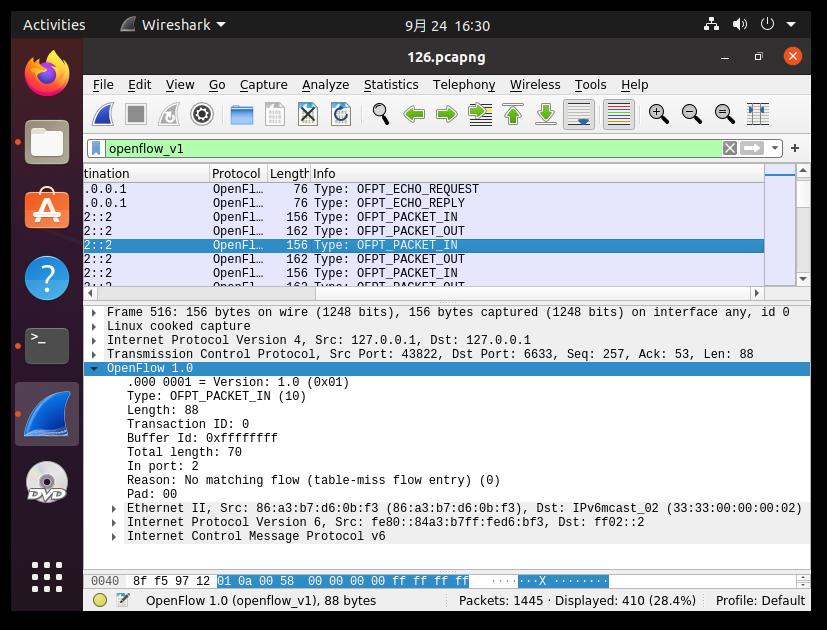
7.OFPT_PACKET_OUT
struct ofp_packet_out {struct ofp_header header;uint32_t buffer_id; /* ID assigned by datapath (-1 if none). */uint16_t in_port; /* Packet's input port (OFPP_NONE if none). */uint16_t actions_len; /* Size of action array in bytes. */struct ofp_action_header actions[0]; /* Actions. *//* uint8_t data[0]; */ /* Packet data. The length is inferredfrom the length field in the header.(Only meaningful if buffer_id == -1.) */};
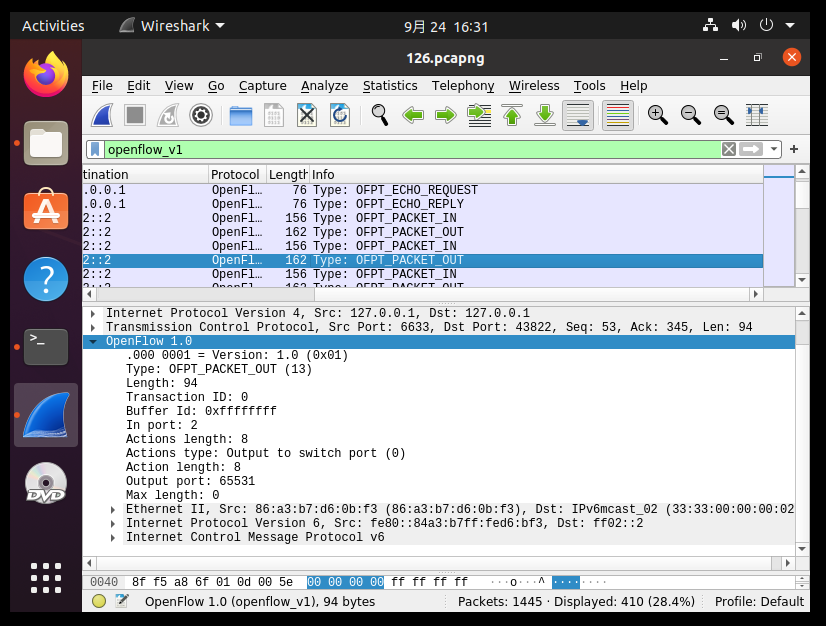
8.OFPT_FLOW_MOD
struct ofp_flow_mod {struct ofp_header header;struct ofp_match match; /* Fields to match */uint64_t cookie; /* Opaque controller-issued identifier. *//* Flow actions. */uint16_t command; /* One of OFPFC_*. */uint16_t idle_timeout; /* Idle time before discarding (seconds). */uint16_t hard_timeout; /* Max time before discarding (seconds). */uint16_t priority; /* Priority level of flow entry. */uint32_t buffer_id; /* Buffered packet to apply to (or -1).Not meaningful for OFPFC_DELETE*. */uint16_t out_port; /* For OFPFC_DELETE* commands, requirematching entries to include this as anoutput port. A value of OFPP_NONEindicates no restriction. */uint16_t flags; /* One of OFPFF_*. */struct ofp_action_header actions[0]; /* The action length is inferredfrom the length field in theheader. */};struct ofp_action_header {uint16_t type; /* One of OFPAT_*. */uint16_t len; /* Length of action, including thisheader. This is the length of action,including any padding to make it64-bit aligned. */uint8_t pad[4];};

四、个人总结
实验难度
本次实验大部分为验证性实验,相对于之前几次实验来说比较简单。主要是验证各个包传递的信息以及从哪里传到哪里。在实验过程中需要不断查阅资料,询问同学,难度算是很正常的。
实验过程遇到的困难及解决办法
- 主要遇到的问题是:经常没办法一次抓包就抓到所需要的全部包,总因为步骤不是很规范导致缺少某个包。
解决方法:最好在建立拓扑之前就打开wireshark,然后拓扑构建完成之后pingall,即可获取到所有的包。
个人感想
这次试验进一步学习了wireshark的使用,对wireshark的各项功能有了更加深刻的理解。其次也认识到了拓扑建立过程中所用到的协议,以及OpenFlow协议的数据交互的机制。有了这些理论知识的铺垫,我认为我能够在接下来的实践过程中游刃有余地完成任务。
实验3:OpenFlow协议分析实践的更多相关文章
- 软件定义网络实验记录⑤--OpenFlow 协议分析和 OpenDaylight 安装
一.实验目的 回顾 JDK 安装配置,了解 OpenDaylight 控制的安装,以及 Mininet 如何连接: 通过抓包获取 OpenFlow 协议,验证 OpenFlow 协议和版本,了解协议内 ...
- 实验 5:OpenFlow 协议分析和 OpenDaylight 安装
一.实验目的 回顾 JDK 安装配置,了解 OpenDaylight 控制的安装,以及 Mininet 如何连接;通过抓包获取 OpenFlow 协议,验证 OpenFlow 协议和版本,了解协议内容 ...
- 实验 5 :OpenFlow 协议分析和 OpenDaylight 安装
实验 5 :OpenFlow 协议分析和 OpenDaylight 安装 一.实验目的 回顾 JDK 安装配置,了解 OpenDaylight 控制的安装,以及 Mininet 如何连接: 通过抓包获 ...
- OpenFlow协议分析
OpenFlow协议分析实验手册 启动虚拟机mininet 和 控制器 ODL 启动wireshark,在控制器的ens32 网卡抓包 使用mininet创建简单拓扑,并连接控制器,指定交换机为ovs ...
- 实验 5:OpenFlow 协议分析和 OpenDaylight 安装
一.实验目的 回顾 JDK 安装配置,了解 OpenDaylight 控制的安装,以及 Mininet 如何连接:通过抓包获取 OpenFlow 协议,验证 OpenFlow 协议和版本,了解协议内容 ...
- SDN学习之OpenFlow协议分析
学习SDN相关的学习也已经有快半年了,期间从一无所知到懵懵懂懂,再到现在的有所熟悉,经历了许多,也走了不少弯路,其中,最为忌讳的便是,我在学习过程中,尚未搞明白OpenFlow协议的情况下,便开始对S ...
- 实战录 | 基于openflow协议的抓包分析
<实战录>导语 云端卫士<实战录>栏目定期会向粉丝朋友们分享一些在开发运维中的经验和技巧,希望对于关注我们的朋友有所裨益.本期分享人为云端卫士安全SDN工程师宋飞虎,将带来基于 ...
- OpenFlow协议1.0及1.3版本分析
OpenFlow是SDN控制器和交换之间交流的协议,在SDN领域有着十分重要的地位. OpenFlow协议发展到现在已经经过了1.0.1.3.1.4等版本.其中1.0和1.3版本使用的是最为广泛的. ...
- 实验八 应用层协议Ⅱ-FTP协议分析
实验八 应用层协议Ⅱ-FTP协议分析 一.实验目的 1.掌握FTP协议的实现原理. 2.了解控制通道和数据通道. 二.实验内容 用WareShark追踪ftp连接. 1.三次握手 2.ftp服务器回发 ...
随机推荐
- cmd关闭端口占用
netstat -nao |findStr "8080" taskkill /pid 15406 /f
- Linux压缩解压 tar.gz格式的文件.查看tomcat是否运行
tar命令详解 -c: 建立压缩档案 -x:解压 -t:查看内容 -r:向压缩归档文件末尾追加文件 -u:更新原压缩包中的文件 这五个是独立的命令,压缩解压都要用到其中一个,可以和别的命令连用但只能用 ...
- C# .NetCore简单实现无限递归的功能
1:在实际开发中,我们会经常使用到无限递归的情况,如菜单,父子级等的情况 2:Code 1 using System; 2 using System.Collections.Generic; 3 us ...
- leaflet加载离线OSM(OpenStreetMap)
本文为博主原创,如需转载需要署名出处. leaflet作为广为应用的开源地图操作的API,是非常受欢迎,轻量级的代码让使用者更容易操作. 废话不多说,下面直接给出范例. 首先在这个网站下载leafle ...
- idea快速搭建Tomcat服务器
创建Web项目 新建Classes和lib文件夹 配置输出路径和资源路径 快捷键ctr+shift+alt+S打开项目配置 在modules下修改输出路径 修改依赖目录 修改war包输出路径 新建to ...
- Typora代码块配色和标题自带序号的实现代码
Typora代码块配色和标题自带序号的实现代码 先打开主题文件夹 文件>偏好设置>外观>打开主题文件夹 然后编辑base.user.css(如果没有就新建一个)文件 /*标题自动添加 ...
- string类型数据的操作指令
1. 2. 3. 4. 5. 6. 7. 8. 9. 从右到左是索引从-1开始 10. 11. 12. 13. 14. 15.
- C# Dapper基本三层架构使用 (三、DAL)
数据访问层(DAL),主要是存放对数据类的访问,即对数据库的添加.删除.修改.更新等基本操作 首先需要在UI层App.Config配置文件中增加连接字符串,如下所示 <connectionStr ...
- node.js一头雾水
开始学习node.js,一头雾水,谁可以告诉我怎么学......欢迎评论留言怎么学node.js的,谢谢 node,node,node,给自己加油 放一张自己设计的日历图鼓励一下:):):),加油.. ...
- etcd学习(10)-etcd对比Consul和zooKeeper如何选型
etcd选型对比 前言 基本架构和原理 etcd Consul ZooKeeper 选型对比 总结 参考 etcd选型对比 前言 对比 Consul, ZooKeeper.选型etcd有那些好处呢? ...
